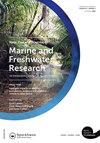Growth and survival of juvenile red abalone ( Haliotis rufescens ) fed invasive macroalgae
IF 1.7
4区 环境科学与生态学
Q3 FISHERIES
New Zealand Journal of Marine and Freshwater Research
Pub Date : 2023-11-12
DOI:10.1080/00288330.2023.2278735
引用次数: 0
Abstract
ABSTRACTAbalone is one of the most important small-scale fisheries in Mexico and is challenged by multiple stressors. For example, the loss of the native main food, Macrocystis pyrifera, and the subsequent takeover of non-indigenous algae species represent a major threat to abalone growth and survival. In Baja California, Mexico two introduced macroalgae, Undaria pinnatifida and Sargassum horneri have become common in the past decade with unknown consequences on native herbivores. In this work, we explored the effect of these invasive algae on the growth and survival of juvenile red abalone, Haliotis rufescens. One hundred and ten juvenile red abalone were tagged and fed with invasive algae U. pinnatifida and S. horneri, and a control with M. pyrifera. Then, the shell length, body weight, and survivorship were assessed monthly for 90 days. Results show that abalone fed U. pinnatifida had a total growth in length, weight, and survivorship, similar to those fed native M. pyrifera. In contrast, abalone fed S. horneri had significantly lower overall performance. Marine heatwaves and other climatic impacts are expected to favour the establishment of invasive species. These results may be relevant to inform local fisheries and management efforts in this area under future scenarios.KEYWORDS: DietSargassum horneriUndaria pinnatifidaWakameMexiconon-indigenous speciesconservation AcknowledgmentsWe are grateful to the farm ‘Abulones Cultivados’ for providing the abalone used in this experiment.Disclosure statementNo potential conflict of interest was reported by the author(s).入侵大藻喂养红鲍鱼幼鱼的生长和存活
tabalone是墨西哥最重要的小规模渔业之一,受到多种压力因素的挑战。例如,本地主要食物pyrifera Macrocystis的丧失,以及随后非本地藻类物种的接管,对鲍鱼的生长和生存构成了重大威胁。在墨西哥的下加利福尼亚州,两种引进的大型藻类,裙带藻和马尾藻在过去十年中变得普遍,对本地食草动物的影响尚不清楚。本研究探讨了这些入侵藻类对红鲍鱼幼鱼生长和存活的影响。对110只红鲍鱼幼鱼进行了标记和饲养,分别饲喂了入侵藻类羽状藻和角藻,并以硫胺素作为对照。然后,每月评估壳长、体重和存活率,为期90天。结果表明,饲喂羽状螺旋藻的鲍鱼在体长、体重、存活率等方面的总体增长与饲喂原生螺旋藻的鲍鱼基本相同。相比之下,鲍鱼喂养的霍氏梭菌的整体性能明显较低。预计海洋热浪和其他气候影响将有利于入侵物种的建立。这些结果可能与未来情景下该地区的当地渔业和管理工作有关。关键词:饲料;马尾藻;羽带藻;;;;;;披露声明作者未报告潜在的利益冲突。
本文章由计算机程序翻译,如有差异,请以英文原文为准。
求助全文
约1分钟内获得全文
求助全文
来源期刊
CiteScore
4.50
自引率
12.50%
发文量
35
审稿时长
3 months
期刊介绍:
Aims: The diversity of aquatic environments in the southern continents and oceans is of worldwide interest to researchers and resource managers in research institutions, museums, and other centres. The New Zealand Journal of Marine and Freshwater Research plays an important role in disseminating information on observational, experimental, theoretical and numerical research on the marine, estuarine and freshwater environments of the region.

 求助内容:
求助内容: 应助结果提醒方式:
应助结果提醒方式:


